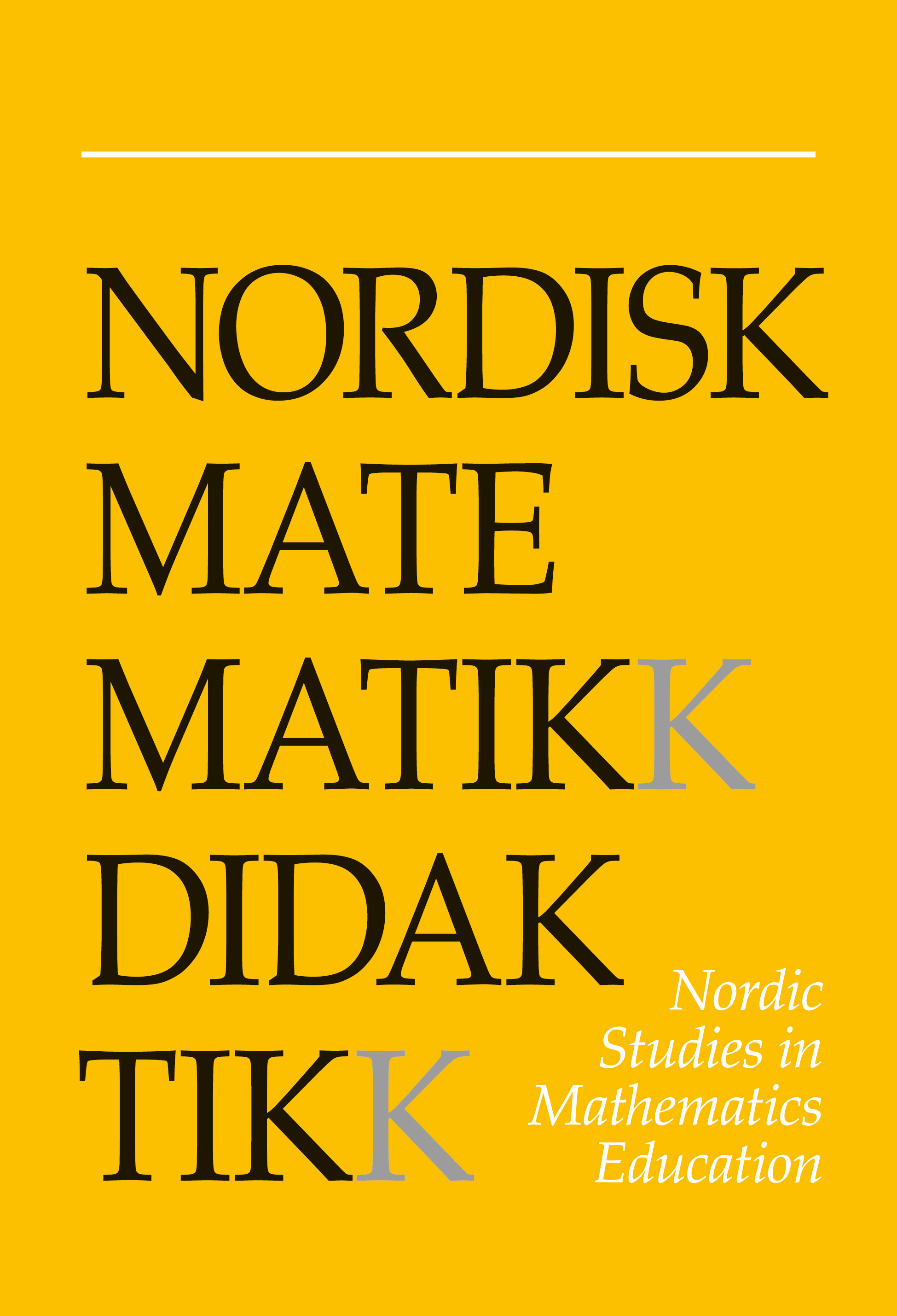Textbooks as instruments – three teachers’ way to organize their mathematics lessons
DOI:
https://doi.org/10.7146/nomad.v11i3.147990Abstract
This paper reports a study of three teachers’ way to organize their lessons and how textbooks are incorporated in their work1. Despite the differences between the teachers, it is noticeable that in these three classrooms, the textbooks, to a large degree, guide the teaching. The textbooks are present: (a) in the students’ individual work, (b) in many of the examples presented on the board, (c) as a source for background and motivational discussions, (d) in how mathematics is presented, and (e) for homework.
References
Alrø, H., & Skovsmose, O. (2002). Dialogue and learning in mathematics education. Intention, reflection, critique (Vol. 29). New York: Kluwer.
Bauersfeld, H. (1988). Interaction, construction, and knowledge: alternative perspectives for mathematics education. In D. A. Grouws, T. J. Cooney & D. Jones (Eds.), Perspective on research on effective mathematics teaching (Vol. 1, pp.27-46). Reston, VA: National Council of Teachers of Mathematics.
Brändström, A. (2005). Differentiated tasks in mathematics textbooks: an analysis of the levels of difficulty. Luleå university of technology.
Carlsson, S., Hake, K.-B., & Öberg, B. (2002). Matte direkt, år 8. Stockholm: Bonnier.
Clarke, D., & Mesiti, C. (2003). Addressing the challenge of legitimate international comparisons: lesson structure in Australia and the USA. In L. Bragg, C. Campbell, G. Herbert & J. Mousley (Eds.), Mathematics education research: innovation, networking, opportunity. Proceedings of the 26th annual conference of the Mathematics Education Research Group of Australasia, Vol. 1 (pp. 230-237). Geelong: MERGA.
Englund, B. (1999). Lärobokskunskap, styrning och elevinflytande. Pedagogisk forskning i Sverige, 4 (4), 327-348.
Englund, T. (1997). Towards a dynamic analysis of the content of schooling: narrow and broad didactics in Sweden. Journal of Curriculum Studies, 29 (3), 267-287. https://doi.org/10.1080/002202797184044
Freeman, D. J., & Porter, A. C. (1989). Do textbooks dictate the content of mathematics instruction in elementary schools? American Educational Research Journal, 26 (3), 403-421. https://doi.org/10.3102/00028312026003403
Hiebert, J., Gallimore, R., Garnier, H., Givvin, K. B., Hollingsworth, H., Jacobs, J., et al. (2003). Teaching mathematics in seven countries. Washington, D.C: US Govt. Printing Office.
Häggblom, J. (2005). From analogue tapes to digital drives: on the development of methods and techniques for classroom interaction research. (D-uppsats). Uppsala University.
Jacobs, J., Garnier, H., Gallimore, R., Hollingsworth, H., Givvin, K. B., Rust, K., et al. (2003). TIMSS 1999 video study. Technical report: mathematics. Washington, D.C: National Center for Education Statistics.
Johansson, M. (2003). Textbooks in mathematics education: a study of textbooks as the potentially implemented curriculum (Licentiate thesis). Department of Mathematics, Luleå University of Technology.
Johansson, M. (2006). Textbooks as instruments: three teachers' way to organize their mathematics lessons. In Teaching mathematics with textbooks: a classroom and curricular perspective (Doctoral thesis). Luleå University of Technology.
Lindqvist, U., Emanuelsson, L., Lindström, J.-O., & Rönnberg, I. (2003). Lusten att lära - med fokus på matematik (Rapport nr. 221). Stockholm: Statens skolverk.
Lundgren, U. P. (1998). The making of curriculum making: reflection on educational research and the use of educational research. In B. G. Gundem & S. Hopmann (Eds.), Didaktik and/or curriculum: an international dialogue (Vol. 41, pp.149-162). New York: Peter Lang.
Löwing, M. (2004). Matematikundervisningens konkreta gestaltning. En studie av kommunikationen lärare - elev och matematiklektionens didaktiska ramar. Göteborg: Acta Universitatis Gothoburgensis.
Palm, T. (2002). The realism of mathematical school tasks. Features and consequences. Umeå University.
Reys, R., Reys, B., Lapan, R., Holliday, G., & Wasman, D. (2003). Assessing the impact of standards-based middle grades mathematics curriculum materials on student achievement. Journal for Research in Mathematics Education, 34 (1), 74-95. https://doi.org/10.2307/30034700
Schmidt, W. H., McKnight, C. C., Houang, R. T., Wang, H., Wiley, D. E., Cogan, L. S., et al. (2001). Why schools matter: a cross-national comparison of curriculum and learning. San Francisco: Jossey-Bass.
Selander, S., & Skjelbred, D. (2004). Pedagogiske tekster: för kommunikasjon og læring. Oslo: Universitetsforlaget.
Skolverket. (2001). Syllabuses for the compulsory school. Stockholm: Fritzes.
Skovsmose, O. (2001). Landscapes of investigation. Zentralblatt fuer Didaktik der Mathematik, 33 (4), 123-132. https://doi.org/10.1007/BF02652747
Sosniak, L. A., & Stodolsky, S. S. (1993). Teachers and textbooks: materials use in four fourth-grade classrooms. The Elementary School Journal, 93 (3), 249-275. https://doi.org/10.1086/461725
Undvall, L., Olofsson, K.-G., & Forsberg, S. (1997). Matematikboken Z röd. Stockholm: Liber AB.
Undvall, L., Olofsson, K.-G., & Forsberg, S. (2002). Matematikboken Y röd. Stockholm: Liber.
Undvall, L., Olofsson, K.-G., & Forsberg, S. (2003). Matematikboken Z röd. Stockholm: Liber.
Downloads
Published
How to Cite
Issue
Section
License

This work is licensed under a Creative Commons Attribution-NonCommercial-ShareAlike 4.0 International License.



